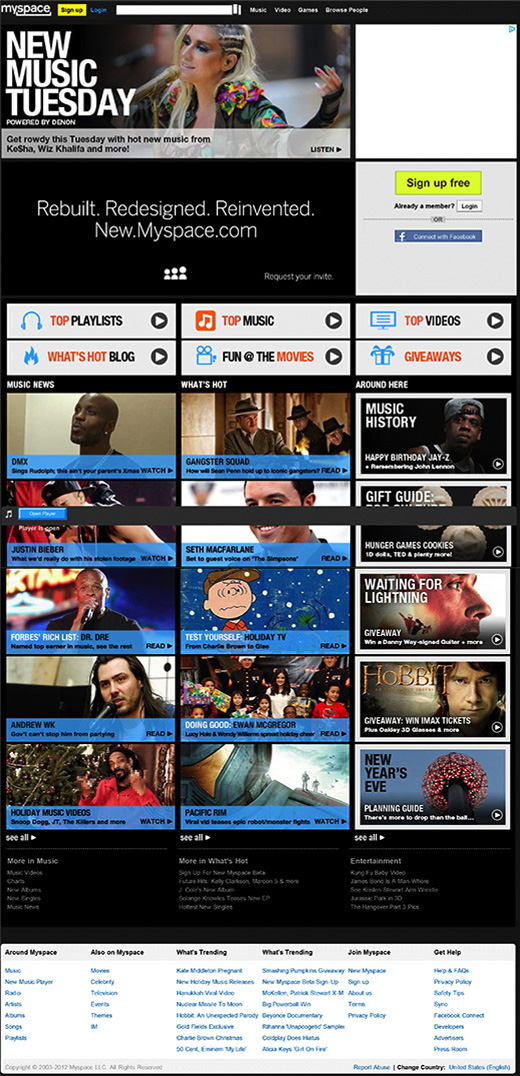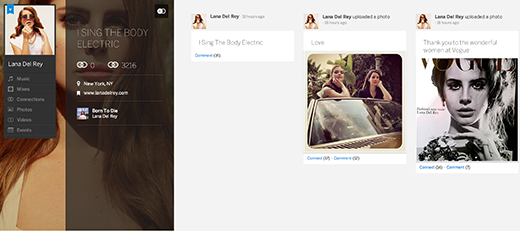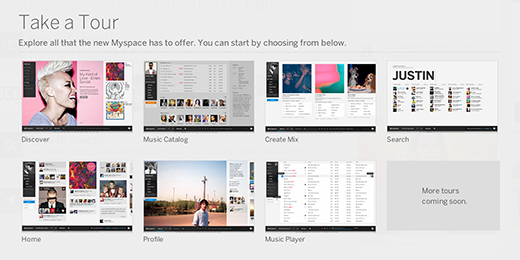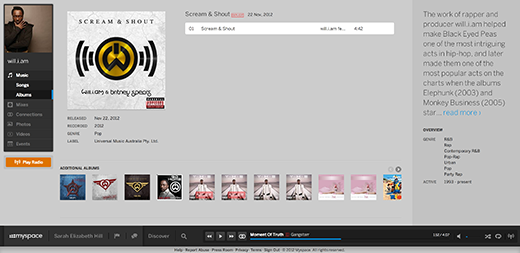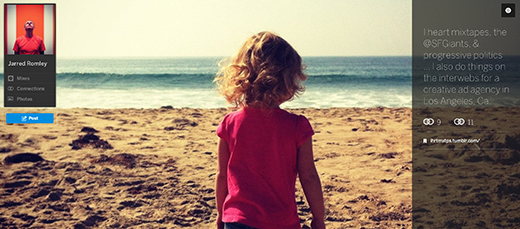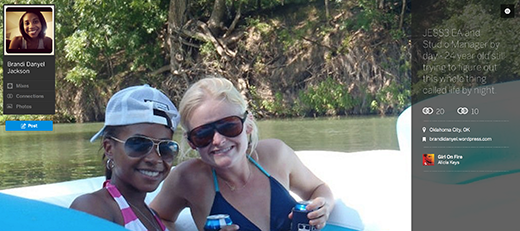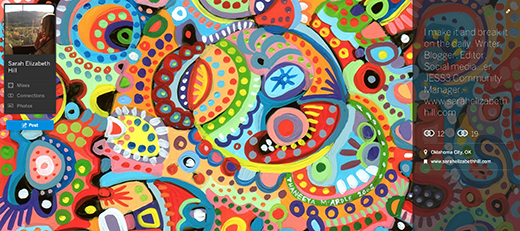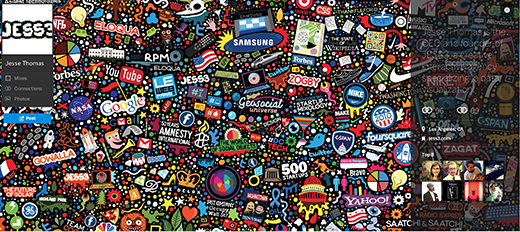
I know Myspace is the social network we love to hate, but I like at least some, if not all, of the layout. It makes Facebook look so boring. It feels like tumblr + spotify + the old ghetto myspace crowd got older and more sophisticated.
It is like Myspace went to jail and just got out clean cut and stronger than ever, but maybe it lost its soul in the process.
JESS3 Reviews
Jarred’s Review:
Associate Director, Strategy & Engagement
Features I like:
• I like that you can listen to continuous music when you are navigating throughout the site.
Features I don’t like:
• There is a definite learning curve. More so then on other new channels I have checked out lately like theFancy.
What’s missing?
• The most obvious is being able to sync up my other social media channels to it.
• People, but they will trickle back.
• It’s missing the Facebook Killer…It doesn’t offer anything to my social media experience that I dont already have.
• What’s the mobile app going to be like? They should sync or buy songkick.
Sustain users?
• No
Additional thoughts:
• I think its beautiful, but as far as usefulness goes, I see it trying to compete for the same users Soundcloud has.
Brandi’s Review:
Executive Assistant & Studio Manager
Features I like:
• As with the old Myspace, the ability to really personalize it.
• Listening to music continuously and the ability to create your own mix (very Spotify of Myspace PS) is also a great perk.
• Ease of uploading pictures and the way your pictures are more like a collage is a sharp look.
Features I don’t like:
• It took a while to get the whole ‘connect’ thing down and how it works with people, music, pictures etc.
• The scroll is a cool concept but it sometimes doesn’t work on my laptop…
What’s missing?
• I wish it was linked to all the other 5 million social media channels I’m on. It would make things easier. I’m all about easy multi social networking updating, but I’m assuming that is to come.
Sustain users?
• I think it will sustain a certain type of user. It’s def more geared towards artists, musicians and probably companies but a general social networking user may find it too involved.
• I see it attracting a younger demographic but not something say my parents would get into like Facebook or even Twitter.
Additional thoughts:
• The look is really cool and will translate to tablets and phones well.
• It’s a good combinations of Twitter, Facebook and Spotify but it takes a lot of user engagement to make it work.
• People are kind of lazy so the harder they have to work to make social networks look and function the way the more likely it will scare some people away.
Sarah’s Review:
Community Manager
Features I like:
• This thing couldn’t be more beautiful.
• It’s very informal. True to the old myspace, you don’t feel weird asking to connect with a stranger.
• Media is obviously key. I like that what you watch and listen to, as well as what you “Connect” with goes onto your timeline.
• You don’t have to watch it and then post it like you do with Facebook – it does all of that announcing work for you. Adding the “Connect” option allows you to publicly identify that you like something as opposed to just simply watching it too.
• The translucence is awesome.
• When you hover over something, the information pops up so you don’t have to leave the page you are on. It’s about time.
Features I don’t like:
• Although the side scroll looks clean, it’s really, really dysfunctional. Almost to the point of being annoying. The scroll catches way too easily.
• It’s just not as easy as the rest of them. Although it keeps track of what you’ve done, you really have to work to find things – even though the search function is lightning fast. Not to mention people are already having multiple pages. Will.i.am has a page and so does his new song w/ Britney.
• I wish content would go over the background image, it seems like a waste of space to have nothing at all over it.
What’s missing?
• People.
• The ability to integrate other social media sites into it.
Sustain users?
• Eh, this is a toss up. I think it will have niche users, mainly because it is not outfitted for the mass public. It’s not easy or simple enough for everyone to understand how to use it, so those who don’t want to take the time to learn it… probably won’t. Those who do take the time, will probably appreciate the features.
• It definitely won’t if they don’t fix all of the glitches that turn what was obviously designed to be a smooth user experience into a rocky-road to glitch-ville.
Additional thoughts:
• Keep trying Myspace, we’re pulling for you (even if it’s secretly).

I know Myspace is the social network we love to hate, but I like at least some, if not all, of the layout. It makes Facebook look so boring. It feels like tumblr + spotify + the old ghetto myspace crowd got older and more sophisticated.
It is like Myspace went to jail and just got out clean cut and stronger than ever, but maybe it lost its soul in the process.
JESS3 Reviews
Jarred’s Review:
Associate Director, Strategy & Engagement
Features I like:
• I like that you can listen to continuous music when you are navigating throughout the site.
Features I don’t like:
• There is a definite learning curve. More so then on other new channels I have checked out lately like theFancy.
What’s missing?
• The most obvious is being able to sync up my other social media channels to it.
• People, but they will trickle back.
• It’s missing the Facebook Killer…It doesn’t offer anything to my social media experience that I dont already have.
• What’s the mobile app going to be like? They should sync or buy songkick.
Sustain users?
• No
Additional thoughts:
• I think its beautiful, but as far as usefulness goes, I see it trying to compete for the same users Soundcloud has.
Brandi’s Review:
Executive Assistant & Studio Manager
Features I like:
• As with the old Myspace, the ability to really personalize it.
• Listening to music continuously and the ability to create your own mix (very Spotify of Myspace PS) is also a great perk.
• Ease of uploading pictures and the way your pictures are more like a collage is a sharp look.
Features I don’t like:
• It took a while to get the whole ‘connect’ thing down and how it works with people, music, pictures etc.
• The scroll is a cool concept but it sometimes doesn’t work on my laptop…
What’s missing?
• I wish it was linked to all the other 5 million social media channels I’m on. It would make things easier. I’m all about easy multi social networking updating, but I’m assuming that is to come.
Sustain users?
• I think it will sustain a certain type of user. It’s def more geared towards artists, musicians and probably companies but a general social networking user may find it too involved.
• I see it attracting a younger demographic but not something say my parents would get into like Facebook or even Twitter.
Additional thoughts:
• The look is really cool and will translate to tablets and phones well.
• It’s a good combinations of Twitter, Facebook and Spotify but it takes a lot of user engagement to make it work.
• People are kind of lazy so the harder they have to work to make social networks look and function the way the more likely it will scare some people away.
Sarah’s Review:
Community Manager
Features I like:
• This thing couldn’t be more beautiful.
• It’s very informal. True to the old myspace, you don’t feel weird asking to connect with a stranger.
• Media is obviously key. I like that what you watch and listen to, as well as what you “Connect” with goes onto your timeline.
• You don’t have to watch it and then post it like you do with Facebook – it does all of that announcing work for you. Adding the “Connect” option allows you to publicly identify that you like something as opposed to just simply watching it too.
• The translucence is awesome.
• When you hover over something, the information pops up so you don’t have to leave the page you are on. It’s about time.
Features I don’t like:
• Although the side scroll looks clean, it’s really, really dysfunctional. Almost to the point of being annoying. The scroll catches way too easily.
• It’s just not as easy as the rest of them. Although it keeps track of what you’ve done, you really have to work to find things – even though the search function is lightning fast. Not to mention people are already having multiple pages. Will.i.am has a page and so does his new song w/ Britney.
• I wish content would go over the background image, it seems like a waste of space to have nothing at all over it.
What’s missing?
• People.
• The ability to integrate other social media sites into it.
Sustain users?
• Eh, this is a toss up. I think it will have niche users, mainly because it is not outfitted for the mass public. It’s not easy or simple enough for everyone to understand how to use it, so those who don’t want to take the time to learn it… probably won’t. Those who do take the time, will probably appreciate the features.
• It definitely won’t if they don’t fix all of the glitches that turn what was obviously designed to be a smooth user experience into a rocky-road to glitch-ville.
Additional thoughts:
• Keep trying Myspace, we’re pulling for you (even if it’s secretly).
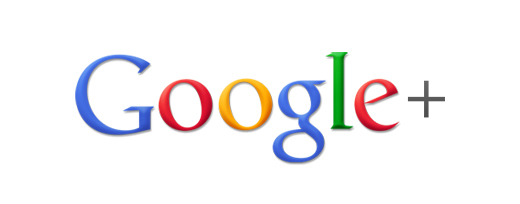
If for no other reason, the excitement around Google+ is warranted because it demonstrates Google’s commitment to doing social right. After experiments-gone-awry by the names of Wave, Buzz and Orkut, Google is back in the game with a product — or “project” as the company prefers to call it — that is hot. G+ is in such high demand that, after they opened the floodgates of invitations the other night, Google had to turn people away the next morning because of what the company called “insane demand.”
Google prefers “project” to “product” because G+ is a work in progress. The potential of Google+ is that it represents an amalgamation of Google tools, including Gchat, Picasa, YouTube, Video Chat, Buzz, +1, and Search. As Google tools become more modular (or widgetized), G+ may integrate them to help aggregate social activity, news, and friends. G+ can be the foundation on which Google builds the future of the social web. If they do that, the competition should take note.

Early opinion of G+ is extremely positive according to a poll of Mashable readers. Less than 10 percent of respondents either gave G+ a shrug or decried it as a useless Facebook copycat, while a majority either find it “nice” or “love it.” (Thirty-two percent are withholding judgment until they get their hands on one of those sought-after invitations.)
As you would expect from Google, G+ offers plenty of fun web technology to play with. The ability to drag and drop friends into “circles” is ahead of its time, and more user-friendly than Twitter‘s Lists or Facebook‘s Friend Lists. And the tool was not made without a touch of whimsy, such as turning friends into a cloud of smoke upon removing them from a Circle.
From a design perspective, G+ is also beating out its competitors at Twitter and Facebook. For instance, there is no indication that users of G+ will have to interact with the tool through intermediary products like HootSuite and Tweetdeck. The layout of G+ is super-streamlined and unembellished with an overwhelming supply of suggestions and features.
Of the few features on offer, perhaps the most fun is “Hangouts,” which permits users to video chat with up to 10 friends. In addition to the design improvements, Hangouts bests Facebook’s Group Chats simply because your Gmail contacts are vastly superior to your Facebook friends. Like Hangouts, other G+ features also integrate well with preexisting Google products. For instance, photos rely on Picasa and videos play on YouTube. I am withholding judgment on “Sparks,” though, which appears to be a thumbnail recommendation engine. (Others, however, are calling it perhaps the most underrated feature of G+.)
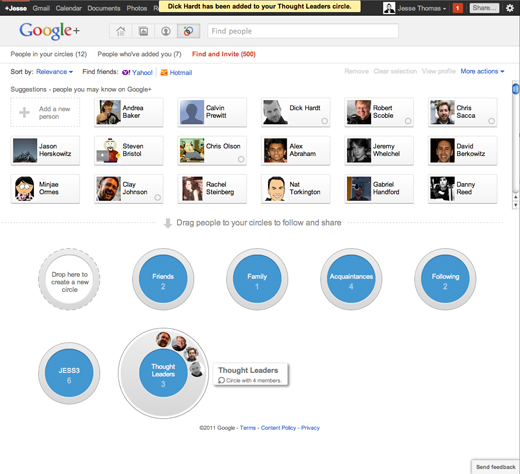
Not so fast though, Google: Facebook is still the place to be. One thing to keep in mind is that social networking is a digital party; we go where our friends, family, and clients go. For social networks, that place remains Facebook. In the short term, that means that Plus may not take off. Rather, it may go down in history as Buzz 2.0, a product that felt like something Yahoo! might have released in its heyday. That assessment may be entirely outdated, however, when G+ integrates documents, questions, events and games.
When will that be, though? One of the biggest risks that Google took with G+ was a relatively public Beta launch. Using G+ feels like like jumping behind the wheel of a car still on the production line. A look back at the rise and fall of Facebook and MySpace, respectively, shows the now-dominant social networking site rising to its throne only once it allowed outside developers the opportunity to create value for the platform through engagement apps. In other words, the Farmville developers of the world deserve their share of the credit for hoisting Facebook to the top of its class.
![]()
The missed opportunity with G+ is that it may alienate early adopters with a product that feels unfinished. Can Google build a better Facebook? That remains to be seen. Whether they can build it before users of G+ abandon this new platform is another question entirely.
Timing is another issue for G+. Mark one for Facebook, whose timing was superb. Lacking the momentum that Facebook owns, with all of our relationships already stored there, Google looks a dollar short and a day late. Well, maybe not a dollar short.
What G+ really represents is another series of shots fired in a larger struggle. My prediction is that in the next five years, Bill Gates will pass control of Microsoft to Zucks over at Facebook. Google and MicroBook will then compete in the world war of digital, buying up brands like Sony, Amazon and Netflix in battles over who will control the media through which we watch movies, listen to music, read books and, of course, socialize.
Disclosure: JESS3 proudly works with three brands mentioned in this post: Google, Facebook and Microsoft.

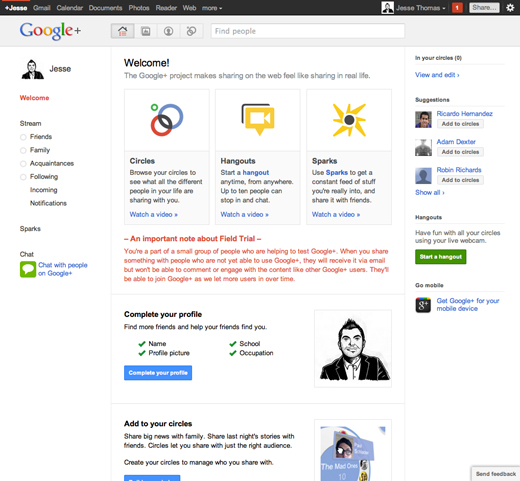
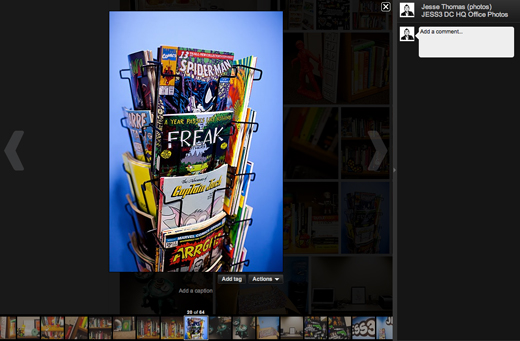
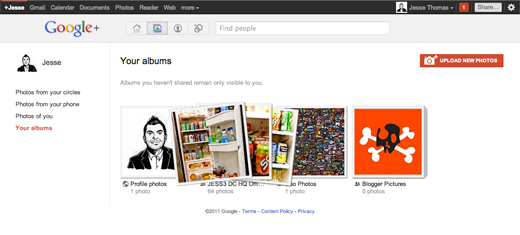
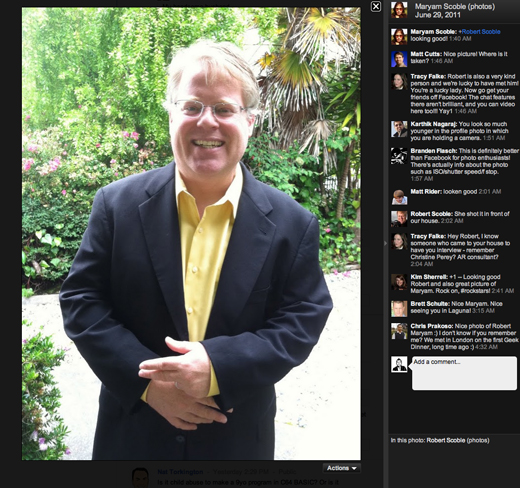
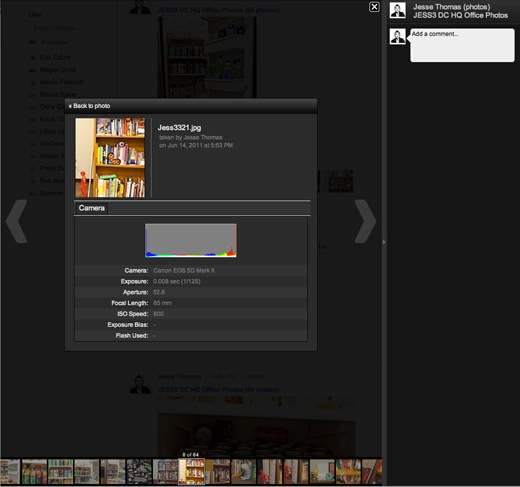
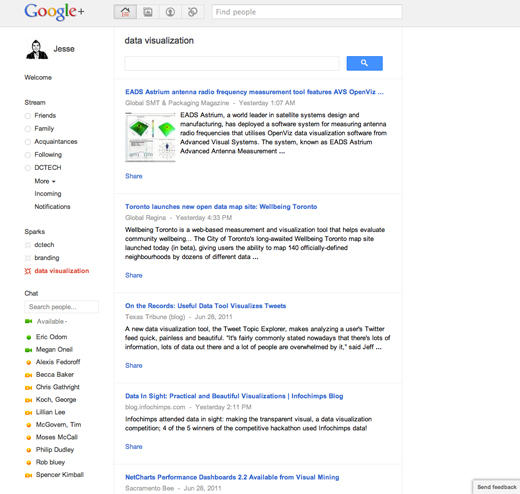

If for no other reason, the excitement around Google+ is warranted because it demonstrates Google’s commitment to doing social right. After experiments-gone-awry by the names of Wave, Buzz and Orkut, Google is back in the game with a product — or “project” as the company prefers to call it — that is hot. G+ is in such high demand that, after they opened the floodgates of invitations the other night, Google had to turn people away the next morning because of what the company called “insane demand.”
Google prefers “project” to “product” because G+ is a work in progress. The potential of Google+ is that it represents an amalgamation of Google tools, including Gchat, Picasa, YouTube, Video Chat, Buzz, +1, and Search. As Google tools become more modular (or widgetized), G+ may integrate them to help aggregate social activity, news, and friends. G+ can be the foundation on which Google builds the future of the social web. If they do that, the competition should take note.

Early opinion of G+ is extremely positive according to a poll of Mashable readers. Less than 10 percent of respondents either gave G+ a shrug or decried it as a useless Facebook copycat, while a majority either find it “nice” or “love it.” (Thirty-two percent are withholding judgment until they get their hands on one of those sought-after invitations.)
As you would expect from Google, G+ offers plenty of fun web technology to play with. The ability to drag and drop friends into “circles” is ahead of its time, and more user-friendly than Twitter‘s Lists or Facebook‘s Friend Lists. And the tool was not made without a touch of whimsy, such as turning friends into a cloud of smoke upon removing them from a Circle.
From a design perspective, G+ is also beating out its competitors at Twitter and Facebook. For instance, there is no indication that users of G+ will have to interact with the tool through intermediary products like HootSuite and Tweetdeck. The layout of G+ is super-streamlined and unembellished with an overwhelming supply of suggestions and features.
Of the few features on offer, perhaps the most fun is “Hangouts,” which permits users to video chat with up to 10 friends. In addition to the design improvements, Hangouts bests Facebook’s Group Chats simply because your Gmail contacts are vastly superior to your Facebook friends. Like Hangouts, other G+ features also integrate well with preexisting Google products. For instance, photos rely on Picasa and videos play on YouTube. I am withholding judgment on “Sparks,” though, which appears to be a thumbnail recommendation engine. (Others, however, are calling it perhaps the most underrated feature of G+.)

Not so fast though, Google: Facebook is still the place to be. One thing to keep in mind is that social networking is a digital party; we go where our friends, family, and clients go. For social networks, that place remains Facebook. In the short term, that means that Plus may not take off. Rather, it may go down in history as Buzz 2.0, a product that felt like something Yahoo! might have released in its heyday. That assessment may be entirely outdated, however, when G+ integrates documents, questions, events and games.
When will that be, though? One of the biggest risks that Google took with G+ was a relatively public Beta launch. Using G+ feels like like jumping behind the wheel of a car still on the production line. A look back at the rise and fall of Facebook and MySpace, respectively, shows the now-dominant social networking site rising to its throne only once it allowed outside developers the opportunity to create value for the platform through engagement apps. In other words, the Farmville developers of the world deserve their share of the credit for hoisting Facebook to the top of its class.
![]()
The missed opportunity with G+ is that it may alienate early adopters with a product that feels unfinished. Can Google build a better Facebook? That remains to be seen. Whether they can build it before users of G+ abandon this new platform is another question entirely.
Timing is another issue for G+. Mark one for Facebook, whose timing was superb. Lacking the momentum that Facebook owns, with all of our relationships already stored there, Google looks a dollar short and a day late. Well, maybe not a dollar short.
What G+ really represents is another series of shots fired in a larger struggle. My prediction is that in the next five years, Bill Gates will pass control of Microsoft to Zucks over at Facebook. Google and MicroBook will then compete in the world war of digital, buying up brands like Sony, Amazon and Netflix in battles over who will control the media through which we watch movies, listen to music, read books and, of course, socialize.
Disclosure: JESS3 proudly works with three brands mentioned in this post: Google, Facebook and Microsoft.







by Mark Suster
]]>by Mark Suster
]]>As we continue deeper into a recession, we will see more deal-based advertising. Groupon and LivingSocial were right to make those inroads early. Sites like Gilt Groupe and PLNDR are being really innovative with their sales strategy, and it’s paying off for them.
Location-based advertising was big in 2010, and it will get even bigger in 2011 as Facebook expands the technology behind its location platform Places. Mobile advertising is of course the larger trend associated with location-based advertising, and it’s also a hot trend.
We can always hope for more smarter and better Google, Twitter and Facebook ad units. Social ads are really exciting, and they have never before been possible. What comes with it is smarter and better metrics.
Last year, we saw some advertisements online that allowed you to click Facebook Connect and suck your permission-based info into a video ad to create a powerful experience. This is in the dynamic ad space that still uses the upload photo trick to get custom content within an ad. I personally find this super interesting and predict we will see more of it for sure in 2011 and beyond.
TV is going to get really exciting for advertisers as well. If you think about it, we haven’t had any good innovations in TV for a long time. With Google and Apple entering the TV market, it will be a great chance for new ad units to be created and tested. If you remember back when Gmail came out and people were flipping out about how the ads next to their emails were related to their emails content, we might have a similar moment with TV ads. In the next few years, we will also start to see better, more powerful remote controls. Perhaps we will see a Facebook “Like” button on TV remotes in the future? Imagine.
Facebook “Like” walls was a big trend this last year. We will see better and smarter strategies around limiting exclusive content on a Facebook page to entice users to click the “Like” button. The trick is turning your customers into fans on the first view of your Facebook page. Most big brands are making a Facebook “Like” box the most prominent thing on their reveal tab for new visitors who haven’t “Liked” the page yet. Another trend we are seeing the big advertisers use is creating an incentive for the customer to become a fan. Exclusive content access is a typical strategy, but we have seen some pretty good ones this year and will continue to see more in 2011. This trend is not without controversy of course, and if you are spending $$$ on Facebook advertising, you can have an official Facebook account person validate your techniques. Our soldier in arms, Matty Mo, coined the term “Reveal Tab”, but I like the term “Like Wall”, because it’s more accurate than referring to it as a tab. A tab is something a user can get to when they want, a wall is something more urgent and alarming frankly.
Facebook “Likes” have become quite valuable this last year and will continue to be the metric marketing departments are judged on. Think about smart ways to drive traffic to your social network presences by promoting your Facebook presence via HTML emails. A trend for 2011 is sending HTML emails driving traffic to Facebook. You can’t “Like” something from an email, but that hasn’t stopped people from using the image of a “Like” to get you to click on a veiled “AddThis” widget. I also like the more unique uses of the “Like” as a metric of popularity. For instance, Urban Outfitters has a page ranking their products by Facebook “Likes”.
As Facebook becomes the front line of a brand, and the image used as the avatar become more important. For instance the image can be tall, designs can blend in (see LeBron James’ Facebook page) and the “Like” wall can be integrated like we see in the LeBron page.
Sponsored content is a great trend that the internet has added great new potential to. Brands that are already in good standing with their customers will find great results with new ways to buy content that their customers care about. We will see more pages like Skittles that would seem to employ comedy writers to keep the content fresh. It would seem that “A Brand’s Best Bet in Social Media Is Randomness.”
Utility is a recession enabled trend. As people have less money, they rely on advertisers to provide things they can survive better with. Obviously coupons is one way of doing this, but providing supplies kids can use around school time, or wrapping paper that can used around the holidays, etc. I think to some extent the comedy you see on the Skittles Facebook page is also utility — by cutting to the chase and providing humor.
Donations are a great new trend we are seeing. From donate your status on Facebook, tweeting to sign a petition, to other more involved forms of engagement. Farmville has done some exciting promotions this year and we will definitely see lots more like this. Farmville had a very successful promotion that allowed the game users to plant virtual seeds in their farm, and then donate the crops to Haiti-related charities.
Giving the user control of options is a great trend that’s here to stay. If you look at how bk.com is setup, I think that says a lot for where we are going. Provide a ton of great relevant content, but allow the user to have as much control as possible.
Visual simplicity means a lot of things. Simplicity can mean that a company is trustworthy. It can mean a company is smart about spending their money, because they don’t need to waste money on pretty images to sell products. I think another factor is companies that look to be spending lots of money are under more and more scrutiny.
Facebook fan acquisition is an emerging trend we saw in 2010. The idea of optimizing the process of securing brand page “Likes” is here to stay. Using A/B testing and optimization techniques, agencies are raising the Facebook fan page numbers for mega brands. I have found that clients just want the numbers to go up. One of the draw backs to this industry trend is the fans one acquires can be low-quality or even irrelevant to the brands ideal target audience.
Influencers are more important when the market is in a recession. If you think about it, people spend longer making purchase decisions and in the process listen to more voices along the way. Services like Klout have come out this last year and created an official layer of social credibility. Klout scores are for instance being used by The Palms Hotel in Vegas to gauge discounts. At The Palms “The Klout Klub,” which “will allow high-ranking influencers to experience Palms’ impressive set of amenities in hopes that these influencers will want to communicate their positive experience to their followers.” Creating thoughtful ways to leverage your influencers is the thing to focus on. People have always said, its cheaper to keep and please the customers you have, than acquire new ones.
Madison Avenue meets Silicon Valley. It used to be the coolest job in advertising was working for an agency. These days working at Google, Facebook, etc has become the dream job of the advertising industry. I think this is good, as we move from disposable online campaigns to robust long term digital campaigns.
Private groups is a trend from the end of 2010 that will continue into 2011. Path has shown us the potential to limiting our social networks to 50 people. Facebook Groups has allowed us to turn Facebook into a meeting room for the long tail of groups we have in our lives. Fast Society is a new iPhone communication service that allows the user to create small groups to text with on the fly, and the groups last for 3 days. Something to consider is the mix or intimacy and urgency.
MySpace is totally the underdog, but in typical underdog fashion, they are fighting to the death. Under the great Mike Jones’s new administration it might be possible to salvage what is an incredible opportunity. The Facebook experience is quite cold, and to be specific — monochromatic. Facebook is two colors, blue and grey (and white doesn’t count). Facebook can get boring, the new MySpace is actually really bright and exciting. MySpace is doing things that Facebook has chosen to never do. I think Facebook suffers from Googlitis and thinks that everything needs to be devoid of design. People think that because Yahoo! and AOL were the platforms with life, and Google and Facebook are the more surgical alternative. MySpace has bright life and tons of potential in 2011. It will be interesting to see what MySpace offers to stay relevant with the main user base, as well as pandering even more to the musician market. I always think about how the difference between MySpace and Facebook is that MySpace has tons of cash and a defined direction, and perhaps Facebook is a bit of a bubble? Something to think about.
LinkedIn is an interesting brand to watch for advertisers. The integrity of its users is way undervalued. One tip is the new “share to LinkedIn” widget. Think about this next to Twitter, Facebook and depending on the site in question, MySpace and Digg.
SlideShare is doing some really exciting things with their platform offerings. You can buy the “featured presentation” or “presentation of the day” for $399 a day and $999 a day respectively. Brands can negotiate with smaller platforms for things Facebook and Twitter won’t do for you, things like customizing the layout of the page in YouTube style. The featured accounts are a great value allowing you to customize the background of the page and add a header to your presentation detail pages. A trend for 2011 will be brands use of SlideShare as a content focused social network.
Quora is a question and answer community, not unlike Yahoo! Answers, or LinkedIn Answers. These sites remind advertisers of the importance of PR. The line between PR and advertising has never been so close. And on this same trend we have seen sites like Get Satisfaction emerge as well. Get Satisfaction allows users to rant and rate on business all over the world. It is kind of like an even more UGC version of Yelp.
]]>As we continue deeper into a recession, we will see more deal-based advertising. Groupon and LivingSocial were right to make those inroads early. Sites like Gilt Groupe and PLNDR are being really innovative with their sales strategy, and it’s paying off for them.
Location-based advertising was big in 2010, and it will get even bigger in 2011 as Facebook expands the technology behind its location platform Places. Mobile advertising is of course the larger trend associated with location-based advertising, and it’s also a hot trend.
We can always hope for more smarter and better Google, Twitter and Facebook ad units. Social ads are really exciting, and they have never before been possible. What comes with it is smarter and better metrics.
Last year, we saw some advertisements online that allowed you to click Facebook Connect and suck your permission-based info into a video ad to create a powerful experience. This is in the dynamic ad space that still uses the upload photo trick to get custom content within an ad. I personally find this super interesting and predict we will see more of it for sure in 2011 and beyond.
TV is going to get really exciting for advertisers as well. If you think about it, we haven’t had any good innovations in TV for a long time. With Google and Apple entering the TV market, it will be a great chance for new ad units to be created and tested. If you remember back when Gmail came out and people were flipping out about how the ads next to their emails were related to their emails content, we might have a similar moment with TV ads. In the next few years, we will also start to see better, more powerful remote controls. Perhaps we will see a Facebook “Like” button on TV remotes in the future? Imagine.
Facebook “Like” walls was a big trend this last year. We will see better and smarter strategies around limiting exclusive content on a Facebook page to entice users to click the “Like” button. The trick is turning your customers into fans on the first view of your Facebook page. Most big brands are making a Facebook “Like” box the most prominent thing on their reveal tab for new visitors who haven’t “Liked” the page yet. Another trend we are seeing the big advertisers use is creating an incentive for the customer to become a fan. Exclusive content access is a typical strategy, but we have seen some pretty good ones this year and will continue to see more in 2011. This trend is not without controversy of course, and if you are spending $$$ on Facebook advertising, you can have an official Facebook account person validate your techniques. Our soldier in arms, Matty Mo, coined the term “Reveal Tab”, but I like the term “Like Wall”, because it’s more accurate than referring to it as a tab. A tab is something a user can get to when they want, a wall is something more urgent and alarming frankly.
Facebook “Likes” have become quite valuable this last year and will continue to be the metric marketing departments are judged on. Think about smart ways to drive traffic to your social network presences by promoting your Facebook presence via HTML emails. A trend for 2011 is sending HTML emails driving traffic to Facebook. You can’t “Like” something from an email, but that hasn’t stopped people from using the image of a “Like” to get you to click on a veiled “AddThis” widget. I also like the more unique uses of the “Like” as a metric of popularity. For instance, Urban Outfitters has a page ranking their products by Facebook “Likes”.
As Facebook becomes the front line of a brand, and the image used as the avatar become more important. For instance the image can be tall, designs can blend in (see LeBron James’ Facebook page) and the “Like” wall can be integrated like we see in the LeBron page.
Sponsored content is a great trend that the internet has added great new potential to. Brands that are already in good standing with their customers will find great results with new ways to buy content that their customers care about. We will see more pages like Skittles that would seem to employ comedy writers to keep the content fresh. It would seem that “A Brand’s Best Bet in Social Media Is Randomness.”
Utility is a recession enabled trend. As people have less money, they rely on advertisers to provide things they can survive better with. Obviously coupons is one way of doing this, but providing supplies kids can use around school time, or wrapping paper that can used around the holidays, etc. I think to some extent the comedy you see on the Skittles Facebook page is also utility — by cutting to the chase and providing humor.
Donations are a great new trend we are seeing. From donate your status on Facebook, tweeting to sign a petition, to other more involved forms of engagement. Farmville has done some exciting promotions this year and we will definitely see lots more like this. Farmville had a very successful promotion that allowed the game users to plant virtual seeds in their farm, and then donate the crops to Haiti-related charities.
Giving the user control of options is a great trend that’s here to stay. If you look at how bk.com is setup, I think that says a lot for where we are going. Provide a ton of great relevant content, but allow the user to have as much control as possible.
Visual simplicity means a lot of things. Simplicity can mean that a company is trustworthy. It can mean a company is smart about spending their money, because they don’t need to waste money on pretty images to sell products. I think another factor is companies that look to be spending lots of money are under more and more scrutiny.
Facebook fan acquisition is an emerging trend we saw in 2010. The idea of optimizing the process of securing brand page “Likes” is here to stay. Using A/B testing and optimization techniques, agencies are raising the Facebook fan page numbers for mega brands. I have found that clients just want the numbers to go up. One of the draw backs to this industry trend is the fans one acquires can be low-quality or even irrelevant to the brands ideal target audience.
Influencers are more important when the market is in a recession. If you think about it, people spend longer making purchase decisions and in the process listen to more voices along the way. Services like Klout have come out this last year and created an official layer of social credibility. Klout scores are for instance being used by The Palms Hotel in Vegas to gauge discounts. At The Palms “The Klout Klub,” which “will allow high-ranking influencers to experience Palms’ impressive set of amenities in hopes that these influencers will want to communicate their positive experience to their followers.” Creating thoughtful ways to leverage your influencers is the thing to focus on. People have always said, its cheaper to keep and please the customers you have, than acquire new ones.
Madison Avenue meets Silicon Valley. It used to be the coolest job in advertising was working for an agency. These days working at Google, Facebook, etc has become the dream job of the advertising industry. I think this is good, as we move from disposable online campaigns to robust long term digital campaigns.
Private groups is a trend from the end of 2010 that will continue into 2011. Path has shown us the potential to limiting our social networks to 50 people. Facebook Groups has allowed us to turn Facebook into a meeting room for the long tail of groups we have in our lives. Fast Society is a new iPhone communication service that allows the user to create small groups to text with on the fly, and the groups last for 3 days. Something to consider is the mix or intimacy and urgency.
MySpace is totally the underdog, but in typical underdog fashion, they are fighting to the death. Under the great Mike Jones’s new administration it might be possible to salvage what is an incredible opportunity. The Facebook experience is quite cold, and to be specific — monochromatic. Facebook is two colors, blue and grey (and white doesn’t count). Facebook can get boring, the new MySpace is actually really bright and exciting. MySpace is doing things that Facebook has chosen to never do. I think Facebook suffers from Googlitis and thinks that everything needs to be devoid of design. People think that because Yahoo! and AOL were the platforms with life, and Google and Facebook are the more surgical alternative. MySpace has bright life and tons of potential in 2011. It will be interesting to see what MySpace offers to stay relevant with the main user base, as well as pandering even more to the musician market. I always think about how the difference between MySpace and Facebook is that MySpace has tons of cash and a defined direction, and perhaps Facebook is a bit of a bubble? Something to think about.
LinkedIn is an interesting brand to watch for advertisers. The integrity of its users is way undervalued. One tip is the new “share to LinkedIn” widget. Think about this next to Twitter, Facebook and depending on the site in question, MySpace and Digg.
SlideShare is doing some really exciting things with their platform offerings. You can buy the “featured presentation” or “presentation of the day” for $399 a day and $999 a day respectively. Brands can negotiate with smaller platforms for things Facebook and Twitter won’t do for you, things like customizing the layout of the page in YouTube style. The featured accounts are a great value allowing you to customize the background of the page and add a header to your presentation detail pages. A trend for 2011 will be brands use of SlideShare as a content focused social network.
Quora is a question and answer community, not unlike Yahoo! Answers, or LinkedIn Answers. These sites remind advertisers of the importance of PR. The line between PR and advertising has never been so close. And on this same trend we have seen sites like Get Satisfaction emerge as well. Get Satisfaction allows users to rant and rate on business all over the world. It is kind of like an even more UGC version of Yelp.
]]>I hung out with Bridget and Justin … we had a great time.
Ate amazing sushi and toured the town in style. Thanks again Justin!!!!
]]>I hung out with Bridget and Justin … we had a great time.
Ate amazing sushi and toured the town in style. Thanks again Justin!!!!
]]>i use linkedin.com and i have made a lot of interesting things happen thru that.. i was impressed by some of the unique features it offers, like.. being able to upload a list of emails and it shows you who has an account. what i did was take a list of ad agency emails i procured =) .. and i pushed them thru this widget on the site for “adding contacts”.. and it showed me who the people were, some CEOs, art directors, marketing managers.. nyc, london, paris.. good shit.. I sent everyone who had an account an email with a link to my portfolio and an invite.. things have gone well.
I love telling that story.. it opens ppls minds to what is possible with these types of things.. i suppose the flip side is people married thru a meeting based on a chat thru the internet?
business deals.. and money? love… and marriage?
I remember this old woman who owned this company I worked for, rich… important.. she was bragging that she sold her car on ebay.com???
I just see that as the tip of the iceberg.. pretty big iceberg..
]]>i use linkedin.com and i have made a lot of interesting things happen thru that.. i was impressed by some of the unique features it offers, like.. being able to upload a list of emails and it shows you who has an account. what i did was take a list of ad agency emails i procured =) .. and i pushed them thru this widget on the site for “adding contacts”.. and it showed me who the people were, some CEOs, art directors, marketing managers.. nyc, london, paris.. good shit.. I sent everyone who had an account an email with a link to my portfolio and an invite.. things have gone well.
I love telling that story.. it opens ppls minds to what is possible with these types of things.. i suppose the flip side is people married thru a meeting based on a chat thru the internet?
business deals.. and money? love… and marriage?
I remember this old woman who owned this company I worked for, rich… important.. she was bragging that she sold her car on ebay.com???
I just see that as the tip of the iceberg.. pretty big iceberg..
]]>